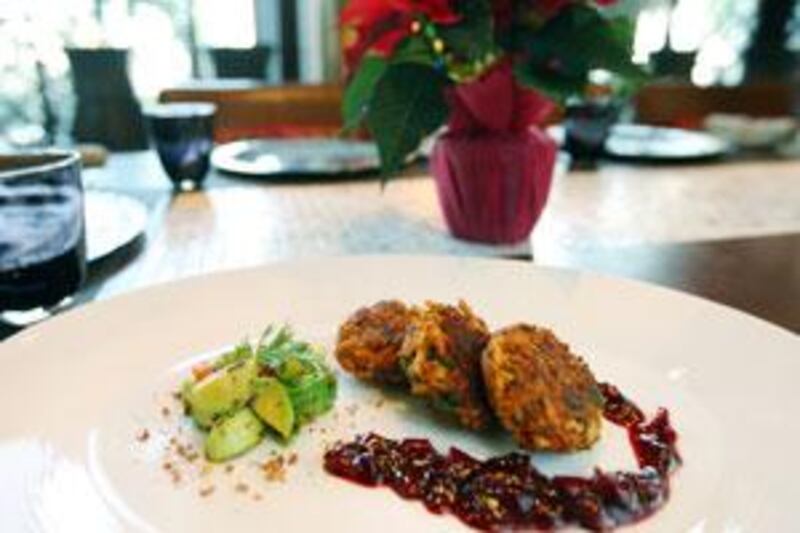In a new weekly column, the author and pastry chef Denise Roig focuses on a single ingredient, drawing on her experience and that of UAE-based chefs and home cooks to share tips and easy-to-follow recipes. Cranberry sauce goes with turkey like hummus goes with pitta, says Emilee Ahern. "It just wouldn't be Thanksgiving dinner without it." Twenty-five years ago, when Ahern first moved to Dubai from her native New Orleans, the small, tart berries were in short supply. Now they're as close as her local grocery store. Spinneys, for example, stocks fresh cranberries from October through December. "No more carrying these essentials of our Thanksgiving dinner back from the US," Ahern says.
Cousin to the blueberry and bilberry, the cranberry is native to the cooler corners of the northern hemisphere. Grown in acidic bogs, the plants have slender, wiry stems and long, trailing vines. Early European settlers in New England thought the flower, stem and petals resembled the neck, head and bill of a crane. Hence the name: cranberry. Of course, Native Americans had been feasting on the berries long before the pilgrims arrived.
While many North Americans serve the jellied form straight out of the can for Thanksgiving and Christmas dinners, fresh cranberries can't be beaten. Not only are they packed with nutrients and antioxidants, they're also wonderful to cook and bake with. Margaret Wynne-Jones, an old friend of Ahern's in Dubai, has been making fresh cranberry sauce for years. ("You don't need to be American to like cranberries," jokes Wynne-Jones, a British expat.) Cranberries for Wynne-Jones are both "Christmassy and summery. They go in so many dishes. I'm very keen, for instance, on casseroles with fruit, using leftover cranberry sauce as a base for casseroled pheasant or guinea fowl. And whipping cranberries into a creamy dessert, such as a syllabub, is a nice relief after the heavy puddings of Christmas Day."
Tomorrow, when Ahern and her husband, Kevin, join a large group of Dubai friends to remember all that they're grateful for, he'll be preparing a Louisiana speciality - deep-fried turkey. They'll have the usual fixings: stuffing, sweet potatoes, and, of course, cranberries. "We usually eat outside at these gatherings. Sometimes the sky has a few clouds. It's cooler. You almost feel a change in the weather coming," Ahern says, adding with a chuckle, "It's about as much autumn as you're going to get here."
This sauce - courtesy of Ahern and Wynne-Jones and slightly adapted - is so simple and so good, you'll never go back to canned. Wynne-Jones's flourish with scooped-out satsumas makes it downright celebratory. At any dinner party, she says, "these always get eaten first." Serves six. Ingredients 300g fresh cranberries 2 large oranges 150g caster sugar 3 satsuma tangerines
Rinse and pick over the cranberries, discarding too-soft berries. Zest and juice both oranges, reserving the zest of one orange. Put the cranberries, juice, sugar and zest of one orange in a medium-sized heavy pot over medium heat. Bring mixture to a boil, then lower the heat to a simmer, leaving the pot uncovered. Cook until the berries have popped and the sauce thickens, bruising the intact berries with a wooden spoon or potato masher. Do not overcook. Slice the satsumas in half and remove the segments of fruit with your fingers, taking care not to tear the skins. (The tangerine pieces can be used in a fruit salad later.) Spoon each satsuma half full with cranberry sauce and sprinkle tops of each with reserved orange zest. Variation: Add two slightly underripe pears (peeled, cored and diced) to the cranberries as they begin to soften.
This tangy side dish, adapted from southernfood.about.com, is a delicious raw combination of flavours, including our local favourite: dates. Makes about a litre. Ingredients 350g fresh cranberries 1 navel orange 1 firm pear 100g chopped dates 225g caster sugar Wash and pick over the cranberries, discarding any that are mushy or damaged. Zest the orange; set zest aside. Quarter the orange, removing not just the peel, but the white fibrous covering and the membranes between the sections. Peel, core and slice the pear into chunks. In the bowl of a food processor, place the cranberries, orange sections, pear and chopped dates. Process for 10 seconds or until you have a finely chopped mixture. (But not a purée.) Spoon the mixture into a medium-sized serving bowl. Stir in orange zest and the sugar, mixing well. Refrigerate for at least three hours for the sugar to dissolve and the relish to thicken.





